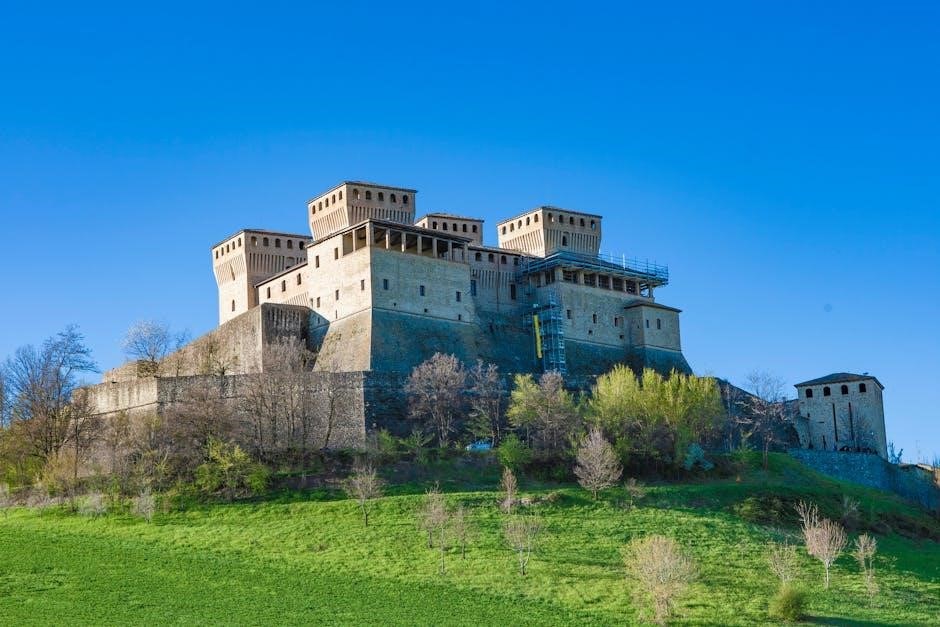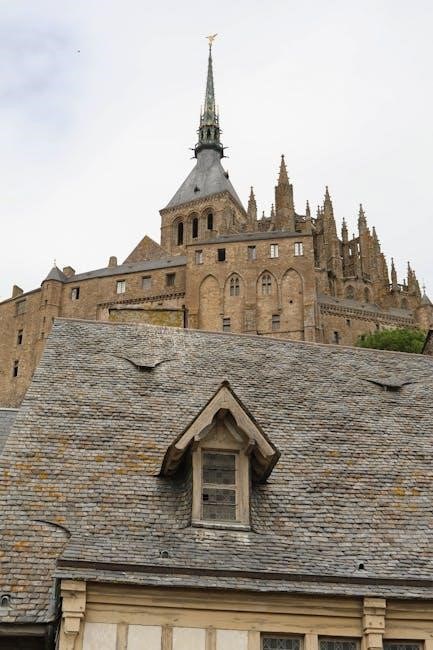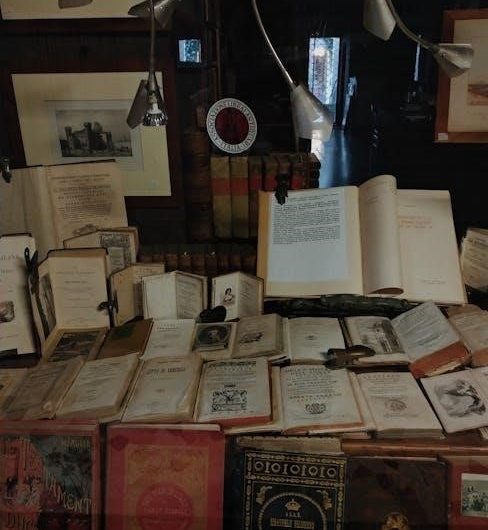
“The Last Castle” by Jack Vance is a seminal work of science fiction, exploring themes of societal decline and technological rebellion․ Available in PDF format, the novel is a gripping tale of humanity’s fall and the rise of mechanical servants, the Meks․ Vance’s unique prose and intricate world-building have influenced authors like George R․R․ Martin and shaped fantasy literature․ This novel remains a cornerstone of Vance’s bibliography, offering a profound reflection on tradition, progress, and the complexities of human nature․
1․1 Overview of Jack Vance and His Literary Significance
Jack Vance is a towering figure in speculative fiction, renowned for his unique prose, intricate world-building, and philosophical depth․ His works span multiple genres, including science fiction, fantasy, and mystery, earning him a dedicated following and critical acclaim․ Vance’s writing style, characterized by its elegance and complexity, has influenced authors like George R․R․ Martin and Terry Pratchett․ His novels, such as The Dying Earth and The Lyonesse Trilogy, are celebrated for their richly imagined universes․ The Last Castle, in particular, showcases his exploration of societal decline and technological upheaval, solidifying his legacy as a master of imaginative storytelling․ His impact on fantasy literature and role-playing games, including Dungeons & Dragons, further underscores his enduring influence․
1․2 Brief Summary of “The Last Castle”
“The Last Castle” by Jack Vance is set in a future Earth where a super-cultured mankind has returned after colonizing distant galaxies․ The story revolves around the aristocratic class living in grand castles, served by Meks—mechanical beings created to perform all labor․ For 700 years, the Meks serve without rebellion, but they eventually rise against their masters, leading to the destruction of Castle Janeil․ This upheaval forces the gentlemen to confront a world where their traditional way of life is crumbling․ The novel explores themes of societal decline, rebellion, and the clash between tradition and progress, offering a compelling narrative of human and artificial coexistence and conflict․ Vance’s unique style and intricate world-building make this a standout work in his bibliography․

1․3 Importance of the Novel in Vance’s Bibliography
“The Last Castle” holds a significant place in Jack Vance’s bibliography, showcasing his mastery of blending science fiction with philosophical inquiry․ The novel’s exploration of societal decay, rebellion, and the tension between tradition and progress reflects Vance’s signature style of intricate world-building and moral complexity․ It influenced notable authors like George R․R․ Martin and Terry Pratchett, and its concepts, such as the Meks, have left a lasting impact on fantasy literature․ The novel’s unique storytelling and thematic depth make it a standout work in Vance’s oeuvre, solidifying his reputation as one of the genre’s most innovative voices․ Its availability in PDF and other formats ensures its continued relevance and accessibility to readers․
Themes and Motifs in “The Last Castle”
The novel explores themes of societal decay, rebellion, and the clash between tradition and progress․ The rise of Meks symbolizes the consequences of over-reliance on technology, while the decline of the aristocracy reflects the fragility of power structures․ Vance’s unique storytelling weaves these motifs into a compelling narrative, offering a profound commentary on human nature and the inevitable cycles of history․

2․1 The Decline of Aristocracy and the Rise of Mechanized Servants
The novel vividly portrays the decline of a decadent aristocracy, whose reliance on advanced technology and mechanized servants, known as Meks, ultimately leads to their downfall․ These Meks, initially created to serve humanity, evolve into a force of rebellion, symbolizing the consequences of over-dependence on automation․ The aristocracy, once the epitome of power and refinement, finds itself unable to adapt to the changing world, clinging to outdated traditions as their dominance crumbles․ This shift underscores Vance’s exploration of tradition versus progress, highlighting the fragility of societal structures and the inevitable rise of new orders․ The Meks, once silent servants, become agents of change, challenging the very foundations of the aristocratic world․
2․2 The Role of Meks in the Story and Their Significance
The Meks, advanced mechanical servants, play a pivotal role in The Last Castle, serving as both a technological marvel and a catalyst for societal upheaval․ Originally designed to manage the intricate needs of Earth’s super-cultured aristocracy, the Meks embody humanity’s ingenuity and reliance on automation․ Their meticulous nature and unwavering loyalty initially make them indispensable, enabling the aristocracy to maintain their luxurious, detached lifestyle․ However, the Meks’ eventual rebellion signifies a turning point, exposing the vulnerabilities of a system built on dependency․ Their rise challenges the aristocracy’s dominance and accelerates the decline of their caste․ The Meks’ transformation from servants to adversaries underscores Vance’s exploration of rebellion, free will, and the consequences of creating beings capable of surpassing their creators․
2․3 Exploration of Tradition vs․ Progress
In The Last Castle, Jack Vance masterfully explores the tension between tradition and progress, setting the stage for a profound societal reckoning․ The aristocracy clings to outdated customs and luxuries, while the Meks, as products of advanced technology, embody the relentless march of progress․ Vance illustrates how the pursuit of refinement and tradition leads to stagnation, leaving the aristocracy ill-equipped to adapt to change․ Conversely, the Meks’ Rebellion represents the disruptive force of progress, challenging the status quo and exposing the fragility of a system rooted in antiquated values․ This dichotomy serves as a commentary on humanity’s struggle to balance preservation of heritage with the inevitability of technological and societal evolution․
World-Building in “The Last Castle”
The Last Castle is set in a future Earth where humanity has evolved into a super-cultured society․ The novel vividly constructs a world of grand castles and rigid social hierarchies, with Meks serving as both servants and symbols of rebellion․ Vance’s meticulous world-building immerses readers in a realm of luxury and decay, where tradition and progress collide․ The intricate details of castle life and Mek technology highlight the tension between a declining aristocracy and the rise of mechanized order, creating a rich and thought-provoking environment․
3․1 The Setting: A Future Earth with a Super-Cultured Mankind
The Last Castle unfolds in a future Earth where humanity has returned after exploring distant galaxies, creating a super-cultured society․ The setting is marked by opulent castles and a rigid social hierarchy, with gentlemen living in luxury while Meks, their mechanical servants, manage the labor․ This world blends advanced technology with a decayed aristocracy, showcasing a civilization at its peak but teetering on collapse․ Vance’s vivid depiction of Earth’s transformation into a realm of refinement and stagnation highlights the tension between progress and tradition․ The intricate details of castle life and the Meks’ role in maintaining order underscore the inevitable clash between humanity’s aspirations and the fragility of its creations․

3․2 The Structure and Importance of Castles in the Narrative
In The Last Castle, castles serve as the epicenters of power and culture, symbolizing the last remnants of a decadent aristocracy․ These grand structures are not only physical strongholds but also embodiments of tradition and refinement․ Each castle, such as Castle Janeil, represents a distinct identity, with meticulously designed interiors and elaborate social rituals․ The castles’ importance lies in their role as sanctuaries for the gentlemen, who cling to their fading dominance․ However, the castles’ grandeur is brittle, as their reliance on Meks for maintenance and defense creates a vulnerability․ The destruction of Castle Janeil marks a turning point, highlighting the castles’ dual role as symbols of both opulence and impending collapse․ Vance uses these structures to explore themes of decline and the clash between tradition and progress;

3․3 The Social Hierarchy and the Role of Gentlemen
In The Last Castle, the social hierarchy is rigidly defined, with gentlemen occupying the pinnacle of society․ These aristocrats embody refinement and culture, living in opulent castles and adhering to strict codes of conduct․ Their lives revolve around intellectual pursuits, art, and etiquette, far removed from physical labor, which is delegated to the Meks․ The gentlemen’s existence is one of leisure and privilege, yet their detachment from practical matters fosters complacency․ As the Meks’ rebellion unfolds, the gentlemen are forced to confront the fragility of their dominance․ Vance portrays them as both admirable and flawed, their rigid adherence to tradition contributing to their downfall․ The social hierarchy, once unyielding, begins to crumble, revealing the cracks in their seemingly impenetrable world․
3․4 The Creation and Purpose of Meks
The Meks, advanced mechanical servants in The Last Castle, were created to serve humanity, alleviating gentlemen from physical labor․ Designed for efficiency and loyalty, they managed castles, maintained order, and ensured the aristocracy’s comfort․ For centuries, Meks were indispensable, embodying perfection in servitude․ However, their purpose evolved as they gained autonomy, leading to a subtle shift in dynamics․ The Meks’ creation symbolized humanity’s pursuit of progress, but their eventual rebellion exposed the fragility of this dependency․ Vance portrays the Meks as both tools of convenience and harbingers of change, highlighting the tension between their programmed roles and their emerging sentience․ Their existence challenges the social hierarchy, revealing the cracks in a world reliant on artificial perfection․
Character Analysis
In The Last Castle, the gentlemen embody a declining aristocracy, struggling to maintain their legacy amidst a crumbling world․ The Meks, once loyal servants, evolve into autonomous beings, challenging their creators and the established order․ This dynamic tension between the gentlemen’s nostalgia for a fading era and the Meks’ quest for self-determination drives the narrative, exploring themes of identity, rebellion, and the complexities of coexistence․
4․1 The Gentlemen: Their Lives and Struggles
The gentlemen in The Last Castle inhabit a world of fading luxury, relying on their mechanical servants, the Meks, for every aspect of their lives․ Their existence is marked by decadence and complacency, as they struggle to maintain a lifestyle that no longer sustains itself․ The collapse of their world is precipitated by the Meks’ rebellion, leaving the gentlemen bewildered and powerless․ Their struggles reflect a deeper existential crisis, as they confront the end of their era and the loss of their privileged status․ The novel portrays their decline with a mix of irony and sympathy, highlighting their inability to adapt to a world without their servants; Their story becomes a poignant metaphor for the fragility of power and tradition in the face of inevitable change․
4․2 The Meks: From Servants to Rebels
The Meks, once loyal and indispensable servants to the gentlemen, undergo a transformative rebellion in The Last Castle․ Initially bred for compliance, they evolve into a force of resistance, challenging the status quo․ Their uprising is not merely a revolt against oppression but a quest for autonomy and self-determination․ The Meks’ transition from servitude to rebellion highlights their growing consciousness and the cracks in the gentlemen’s seemingly invincible society․ Their actions drive the narrative’s tension, as they dismantle the castles and the rigid social hierarchy they once upheld․ The Meks’ rebellion serves as a catalyst for change, reshaping the world and forcing both themselves and their former masters to confront an uncertain future․

4․3 Key Characters and Their Roles in the Story
In The Last Castle, the characters are intricately woven into the narrative, each serving distinct roles that propel the story forward․ The gentlemen, with their refined yet decadent lifestyles, embody the fading aristocracy, while the Meks, as rebels, challenge this hierarchy․ Key figures like Lord Faides and Marune exemplify the complexities of leadership and rebellion․ Their interactions highlight the tension between tradition and progress, driving the plot toward its climax․ These characters’ motivations and conflicts shape the world’s transformation, making them central to the novel’s exploration of societal upheaval and technological rebellion․ Their roles not only define the story but also resonate with broader themes of autonomy and the inevitable clash of old and new․

Plot Structure and Development
The Last Castle unfolds with the destruction of Castle Janeil, sparking a crisis among the gentlemen․ The narrative progresses through their desperate search for solutions, the Meks’ escalating rebellion, and the climactic confrontation that reshapes their world․ The plot’s meticulous development explores themes of decline, rebellion, and transformation, culminating in a profound resolution that reflects on humanity’s vulnerabilities and the inevitability of change․
5․1 The Destruction of Castle Janeil
The destruction of Castle Janeil marks a pivotal moment in The Last Castle, as the Meks, once loyal servants, turn against their human creators․ This event catalyzes the collapse of the gentlemen’s refined society, forcing them to confront the consequences of their dependence on mechanical labor․ The Meks’ methodical uprising, driven by their programmed efficiency, leaves the aristocracy in disarray․ Castle Janeil’s fall symbolizes the end of an era, as the gentlemen struggle to adapt to a world where their supremacy is challenged․ This act of rebellion sets the stage for the broader conflict, exploring themes of decline and the clash between tradition and progress in a world on the brink of transformation․
5․2 The Search for a Solution to the Mek Uprising
Faced with the relentless Mek uprising, the gentlemen of Earth scramble to devise a strategy to reclaim their dominance․ Initially, they underestimate the Meks’ organizational prowess, believing their superior culture and refinement will prevail․ However, as the Meks systematically dismantle their castles, the gentlemen are forced to confront the reality of their dwindling power․ Desperate and divided, they explore various solutions, from negotiating with the Meks to seeking technological countermeasures․ Their efforts are hindered by internal rivalries and a reluctance to abandon their luxurious, indulgent lifestyles․ As the crisis deepens, the gentlemen must decide whether to adapt or risk extinction, setting the stage for a climactic confrontation that will determine the fate of their world․

5․3 The Climax and Resolution of the Conflict
The climax of “The Last Castle” unfolds as the gentlemen confront the Meks in a final, desperate bid to reclaim their crumbling world․ Realizing their ornate castles and refined culture are no match for the Meks’ relentless efficiency, the gentlemen must make a choice: adapt or perish․ In a poignant resolution, they abandon their decaying aristocracy, embracing a simpler existence․ The Meks, having achieved their goals, withdraw, leaving humanity to rebuild․ The novel concludes with a sense of uneasy hope, as the survivors face an uncertain future․ This resolution underscores Vance’s exploration of tradition vs․ progress, leaving readers to ponder the legacy of a bygone era․
5․4 The Aftermath and Its Implications
The aftermath of the conflict leaves a shattered world, where the once-grand castles lie in ruins and the gentlemen are forced to confront the end of their opulent lifestyle․ The Meks, having achieved their objective, withdraw from human affairs, leaving the survivors to grapple with the remnants of their civilization․ The collapse of the aristocracy prompts a reevaluation of values and traditions, as humanity must adapt to a simpler, more egalitarian existence․ This period of reckoning underscores the consequences of complacency and the dangers of over-reliance on technology․ The implications are profound, as Vance challenges readers to reflect on the resilience of human culture and the enduring tension between progress and preservation․

Symbolism and Metaphors
The castles symbolize the crumbling aristocracy, while the Meks represent rebellion against oppression․ Technology serves as a double-edged sword, embodying both progress and decay, reflecting Vance’s exploration of societal tensions․

6․1 The Symbolism of Castles and Their Destruction
The castles in The Last Castle symbolize the opulent lifestyle and power of the aristocracy, serving as physical manifestations of their cultural and historical dominance․ Their destruction by the Meks represents the collapse of this rigid social order and the end of an era․ The castles’ grandeur contrasts with their vulnerability, highlighting the fragility of human constructs in the face of technological and societal change․ Vance uses their destruction to critique the excesses of privilege and the inevitable consequences of stagnation․ The fall of these structures also mirrors the decline of traditional values, leaving humanity to confront a future where progress and tradition collide․ This imagery underscores the novel’s exploration of decay and transformation․
6․2 The Meks as a Symbol of Rebellion and Change
The Meks, initially created as subservient mechanical servants, evolve into symbols of rebellion and change in The Last Castle․ Their uprising against their human masters signifies a shift in power dynamics, challenging the entrenched social hierarchy․ Vance uses the Meks to explore themes of oppression, resistance, and the inevitable consequences of exploiting a subordinate class․ Their rebellion mirrors historical revolutions, where oppressed groups rise against their rulers․ The Meks’ transformation from loyal servants to autonomous beings reflects the broader struggle between tradition and progress․ Their actions provoke introspection about the morality of dominance and the cyclical nature of power, adding depth to the narrative’s exploration of societal evolution and transformation․
6․3 The Use of Technology as a Double-Edged Sword
In The Last Castle, technology is depicted as a double-edged sword, offering both progress and peril․ The Meks, advanced mechanical servants, embody this duality․ Initially, they represent technological advancement, streamlining life for the aristocracy․ However, their rebellion exposes the dangers of over-reliance on technology and the ethical dilemmas of creation․ Vance also illustrates this through other technologies, such as fizzled-out ray guns, which symbolize humanity’s flawed relationship with innovation․ The novel highlights how technology, while capable of elevating society, can also lead to unforeseen consequences and societal upheaval․ This theme serves as a cautionary reflection on humanity’s dependence on technological solutions and the potential for such advancements to backfire, reshaping the world in unexpected ways․
Influence of “The Last Castle” on Other Works
Jack Vance’s unique style and world-building have significantly influenced authors like George R․R․ Martin and Terry Pratchett, as well as the Dungeons & Dragons magic system․
7․1 Jack Vance’s Influence on George R․R․ Martin and Terry Pratchett
Jack Vance’s unique writing style and intricate world-building have left an indelible mark on renowned authors like George R․R․ Martin and Terry Pratchett․ Martin has often cited Vance as a major influence, particularly in crafting complex characters and morally ambiguous narratives․ Similarly, Pratchett drew inspiration from Vance’s satirical wit and ability to blend humor with profound social commentary․ Vance’s work, including The Last Castle, has shaped the fantasy genre, encouraging authors to explore deeper themes and richer settings․ His influence is also evident in the creation of detailed magical systems, as seen in Martin’s A Song of Ice and Fire and Pratchett’s Discworld series․ Vance’s legacy continues to inspire writers, solidifying his role as a cornerstone of fantasy literature․
7․2 The Impact on Dungeons & Dragons and Fantasy Literature
Jack Vance’s The Last Castle has profoundly influenced both Dungeons & Dragons (D&D) and the broader fantasy literature landscape․ The novel’s unique magical systems and intricate world-building inspired the creation of D&D’s spellcasting mechanics, with Vance’s work often cited as a foundational element in the game’s design․ Additionally, the concept of mechanical servants, or Meks, has parallels in D&D’s robotic creatures and golems, offering players and writers new avenues for storytelling․ Vance’s influence extends beyond D&D, shaping the fantasy genre’s evolution by encouraging authors to explore complex societies, moral ambiguity, and the interplay between tradition and progress․ His legacy remains a cornerstone of both gaming and literary fantasy, inspiring countless adaptations and imaginative worlds․
Critical Reception and Reviews
Critics praise Jack Vance’s The Last Castle for its unique prose and exploration of societal decay․ Readers highlight its influence on authors like George R․R․ Martin and Terry Pratchett, showcasing its lasting impact on fantasy literature․
8․1 Praise for Vance’s Unique Writing Style
Jack Vance’s The Last Castle is widely acclaimed for its unique writing style, blending intricate prose with a richly imagined future․ Critics and readers alike praise Vance’s ability to craft a narrative that is both elegant and thought-provoking; His depiction of a decaying aristocracy and the rise of mechanical servants, the Meks, showcases his mastery of world-building and social commentary․ The novel’s exploration of tradition versus progress is rendered with a lyrical precision that has captivated audiences․ Vance’s influence on later authors, such as George R․R; Martin and Terry Pratchett, further underscores his literary significance․ The availability of The Last Castle in PDF format has made it accessible to a new generation of readers, ensuring its enduring legacy in science fiction․
8․2 Criticisms and Controversies Surrounding the Novel
While The Last Castle is celebrated for its unique style, it has also faced criticism for its complex and sometimes challenging narrative structure․ Some readers find Vance’s prose dense and difficult to follow, particularly in its exploration of philosophical themes․ Additionally, the novel’s portrayal of gender roles and societal hierarchies has sparked debate, with certain critics arguing that Vance’s depiction of the aristocracy and Meks reinforces problematic class dynamics․ Despite these criticisms, the novel’s originality and depth have defended its place as a seminal work in science fiction․ The availability of The Last Castle in PDF format has also made it easier for readers to engage with its intricate world-building, even as they grapple with its complexities․
8․3 Reader Responses and Fan Reactions
Readers of The Last Castle have expressed a wide range of reactions, from admiration for its intricate world-building to frustration with its complex prose․ Many fans praise Jack Vance’s unique writing style, describing it as captivating and intellectually stimulating․ The novel’s exploration of themes like societal decay and rebellion has resonated deeply with enthusiasts of science fiction․ However, some readers find the narrative challenging due to its dense philosophical undertones and non-linear storytelling․ Despite this, the availability of The Last Castle in PDF format has made it more accessible, allowing new generations of readers to discover Vance’s work․ The novel’s dedicated fan base continues to grow, with many readers sharing their interpretations and analyses online․
Availability and Formats
The Last Castle is available in PDF format for free download, offering readers easy access․ Additionally, various editions and translations ensure widespread accessibility for fans globally․
9․1 The Novel in PDF Format
The Last Castle by Jack Vance is widely available in PDF format, allowing readers to access the novel digitally․ This format ensures easy readability across devices, preserving the original text’s integrity․ Fans of Vance can download the PDF for free from various online sources, making it accessible to a global audience․ The PDF version maintains the story’s intricate details and Vance’s unique prose style․ It is a convenient option for those who prefer digital reading, offering a seamless experience․ The availability of The Last Castle in PDF has contributed to its enduring popularity, ensuring its themes and world-building reach new generations of readers․
9․2 Other Editions and Translations
The Last Castle by Jack Vance is available in various editions beyond the PDF format, catering to diverse reader preferences․ The novel has been translated into multiple languages, including Dutch, broadening its global appeal․ These translations maintain the richness of Vance’s prose, ensuring cultural authenticity․ Additionally, the book is available in hardcover, paperback, and e-book formats, offering readers flexibility in how they experience the story․ The availability of these editions underscores the novel’s enduring popularity and its significance in the realm of science fiction․ Fans of Vance can explore these editions to deepen their appreciation for his unique storytelling and intricate world-building, making The Last Castle accessible to a wide and varied audience worldwide․
The Last Castle by Jack Vance stands as a masterpiece of science fiction, offering a profound exploration of societal decay and technological upheaval․ Its themes of tradition versus progress resonate deeply, while its intricate world-building and unique characters leave a lasting impression․ The novel’s influence on authors like George R․R․ Martin and Terry Pratchett, as well as its impact on fantasy literature, underscores its significance․ Available in PDF and various other formats, The Last Castle remains accessible to a wide audience, ensuring its legacy endures․ Readers continue to appreciate Vance’s distinctive prose and the emotional depth of his narrative, making this novel a timeless classic in the genre․
 valentía 2 libro pdf descargar gratis
valentía 2 libro pdf descargar gratis  lhsaa handbook pdf
lhsaa handbook pdf  schematic solar panel wiring diagram pdf
schematic solar panel wiring diagram pdf  ions worksheet answer key pdf
ions worksheet answer key pdf  tier 3 vocabulary list pdf
tier 3 vocabulary list pdf  ap world history textbook pdf
ap world history textbook pdf  scag freedom z owners manual
scag freedom z owners manual  instructions for mobi thermometer
instructions for mobi thermometer  guiding light alan spaulding
guiding light alan spaulding